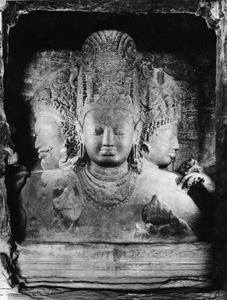
And how sure are we? to think that mahabalipuram already flaunts 2 other reclining vishnus not too far away in the mahishasuramardhini cave as well as in the heart of the shore temple, it appears that vishnu had a very strong role to play as a cult deity paralleling shiva, who seems to have gained reasonably strong ground in these regions. whats even more interesting is that apart from this form vishnu has been depicted in his varaha incarnate as well as trivikrama in the varaha cave. These is interestingly the krishna govardhana panel that cannot be ignored, but all in all there is no garuda depicted, instead we have a boar right next to the shore temple. The boar is the varaha incarnate and definitely not the vahana as it would project itself to be in this case.
So coming back to the unfinished rock we see at the left of the Bhima ratha (not visible here) its very clear that there is a strong possibility of a boar being carved out of this rock more than garuda, as we have previously seen next to the shore temple. Inicidentally, the rock is unfinished, but there is no indication that a boar could have been carved there. yet given the trend of the way things seemed to have worked there, its highly possible that a boar would have taken position next to the Bhima ratha indicating this cave being dedicated to Vishnu.
Pulling ourselves a step away, is there a point we are beginning to see here? The rathas seem to be dedicated to the respective deities, Mother goddess, Shiva, vishnu, Indra ... the only ratha that does not follow the rule is the Dharmaraja ratha, which takes on Shiva, and displays an entire calatogue of shiva iconography on its walls.
truely amazing apart from iconography is also the architectural elements of this ratha. this is one of the few monuments that seems to have taken after the chaitya graha at Besra, this again is quoting J C Harle. Interesting opinion as we notice very clearly that a small cell in the besra monument has very beautifully been depicted here on monolithic rock on the roof of Bhima ratha. even more interesting is that most of the old houses (wooden prototypes) depicted on the bharut and sanchi stupa have remote resemblances with this roof!
Interestingly the botton line is that the main arched window atop most of the structures seems to be the main source of light into these houses. Very close to the buddhist chaitya graha - or the later cathedrals for that matter. yet the corners indicate barrel vaulted roof which has a stupa at the far end - altar maybe. The pillars like the rest of the monuments echoes pallava style with squarting yalis at the base.
Interestingly this ratha is also the prototype to later Gopurams that sprang up during the later pallava and chola periods. If you had to add more of this roof to itself and taper them as you go along, you end up with a gopuram. Interestingly, the ganesha ratha is a clear indicator of such innovations in architecture. The finial of this structure seems to find itself not only at the roof (currently destroyed) but around the rathas as well, specifically the draupadi ratha! Am yet to figure out their function. The main decor of the roof has a kapota and a line of shala kutas and karna kutas forming one hara above the pillars. These are interspaced with smaller arched windows or gavakshas also called kudus in Tamil.





